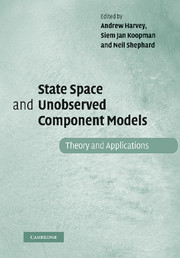Book contents
- Frontmatter
- Contents
- Preface
- Acknowledgements
- Part I State space models
- Part II Testing
- 4 Frequency domain and wavelet-based estimation for long-memory signal plus noise models
- 5 A goodness-of-fit test for AR(1) models and power against state space alternatives
- 6 Tests for cycles
- Part III Bayesian inference and bootstrap
- Part IV Applications
- References
- Author index
- Subject index
6 - Tests for cycles
Published online by Cambridge University Press: 06 January 2010
- Frontmatter
- Contents
- Preface
- Acknowledgements
- Part I State space models
- Part II Testing
- 4 Frequency domain and wavelet-based estimation for long-memory signal plus noise models
- 5 A goodness-of-fit test for AR(1) models and power against state space alternatives
- 6 Tests for cycles
- Part III Bayesian inference and bootstrap
- Part IV Applications
- References
- Author index
- Subject index
Summary
Abstract
This article presents a model-based approach to the investigation of cyclical properties of a time series. It is shown how models for stochastic cycles, both stationary and nonstationary, may be set up and how deterministic cycles emerge as a special case. The Lagrange multiplier principle is used to formulate a test of the null of a deterministic cycle against the alternative of a stochastic cycle and a test of a nonstationary against a stationary cycle. Similar ideas are used to set up a test against the presence of any kind of cycle. All the test statistics have asymptotic distributions that belong to the Cramér-von Mises family under the null. A Wald test against a deterministic cycles is also described as is a test of the null hypothesis that the series contains a permanent cycle. The modelling framework may be extended to include other components, such as trends, and explanatory variables. Finally it is argued that cycles are best detected by fitting models rather than by examining the periodogram.
Introduction
The traditional paradigm of spectral analysis is one in which deterministic cycles are embedded in a stationary indeterministic process. By allowing the initial conditions to be random, these deterministic cycles can be set up so as to be stationary, as in the Wold decomposition. Deterministic cycles are often identified from large periodogram ordinates. Tests of significance of these ordinates may then be carried out, a famous early example being that of Fisher (1929). However, Priestley (1981, Chapter 8) cautioned against identifying cycles from the periodogram since this is normally computed at only T/2 discrete points and these points may not correspond to the frequencies in the series.
- Type
- Chapter
- Information
- State Space and Unobserved Component ModelsTheory and Applications, pp. 102 - 120Publisher: Cambridge University PressPrint publication year: 2004
- 4
- Cited by

